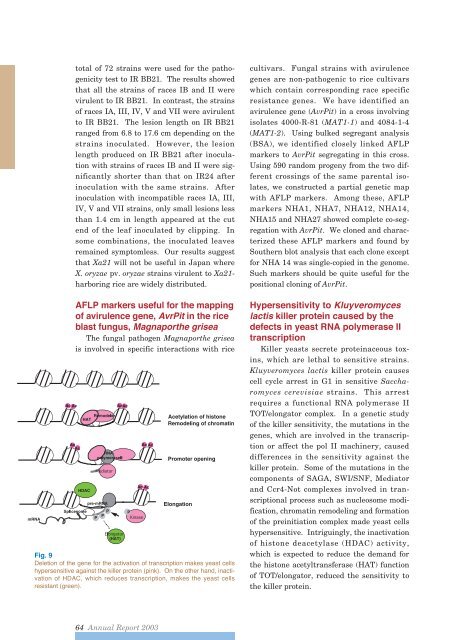Create successful ePaper yourself
Turn your PDF publications into a flip-book with our unique Google optimized e-Paper software.
total of 72 strains were used for the pathogenicitytest to IR BB21. The results showedthat all the strains of races IB and II werevirulent to IR BB21. In contrast, the strainsof races IA, III, IV, V and VII were avirulentto IR BB21. The lesion length on IR BB21ranged from 6.8 to 17.6 cm depending on thestrains inoculated. However, the lesionlength produced on IR BB21 after inoculationwith strains of races IB and II were significantlyshorter than that on IR24 afterinoculation with the same strains. Afterinoculation with incompatible races IA, III,IV, V and VII strains, only small lesions lessthan 1.4 cm in length appeared at the cutend of the leaf inoculated by clipping. Insome combinations, the inoculated leavesremained symptomless. Our results suggestthat Xa21 will not be useful in Japan whereX. oryzae pv. oryzae strains virulent to Xa21-harboring rice are widely distributed.AFLP markers useful for the mappingof avirulence gene, AvrPit in the riceblast fungus, Magnaporthe griseaThe fungal pathogen Magnaporthe griseais involved in specific interactions with riceFig. 9Deletion of the gene for the activation of transcription makes yeast cellshypersensitive against the killer protein (pink). On the other hand, inactivationof HDAC, which reduces transcription, makes the yeast cellsresistant (green).cultivars. Fungal strains with avirulencegenes are non-pathogenic to rice cultivarswhich contain corresponding race specificresistance genes. We have identified anavirulence gene (AvrPit) in a cross involvingisolates 4000-R-81 (MAT1-1) and 4084-1-4(MAT1-2). Using bulked segregant analysis(BSA), we identified closely linked AFLPmarkers to AvrPit segregating in this cross.Using 590 random progeny from the two differentcrossings of the same parental isolates,we constructed a partial genetic mapwith AFLP markers. Among these, AFLPmarkers NHA1, NHA7, NHA12, NHA14,NHA15 and NHA27 showed complete co-segregationwith AvrPit. We cloned and characterizedthese AFLP markers and found bySouthern blot analysis that each clone exceptfor NHA 14 was single-copied in the genome.Such markers should be quite useful for thepositional cloning of AvrPit.Hypersensitivity to Kluyveromyceslactis killer protein caused by thedefects in yeast RNA polymerase IItranscriptionKiller yeasts secrete proteinaceous toxins,which are lethal to sensitive strains.Kluyveromyces lactis killer protein causescell cycle arrest in G1 in sensitive Saccharomycescerevisiae strains. This arrestrequires a functional RNA polymerase IITOT/elongator complex. In a genetic studyof the killer sensitivity, the mutations in thegenes, which are involved in the transcriptionor affect the pol II machinery, causeddifferences in the sensitivity against thekiller protein. Some of the mutations in thecomponents of SAGA, SWI/SNF, Mediatorand Ccr4-Not complexes involved in transcriptionalprocess such as nucleosome modification,chromatin remodeling and formationof the preinitiation complex made yeast cellshypersensitive. Intriguingly, the inactivationof histone deacetylase (HDAC) activity,which is expected to reduce the demand forthe histone acetyltransferase (HAT) functionof TOT/elongator, reduced the sensitivity tothe killer protein.64 <strong>Annual</strong> <strong>Report</strong> <strong>2003</strong>













